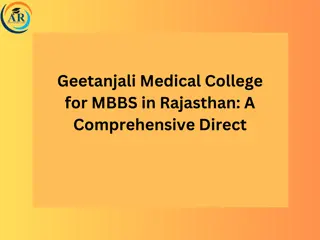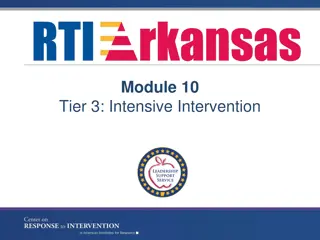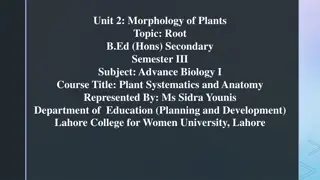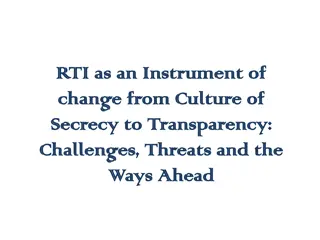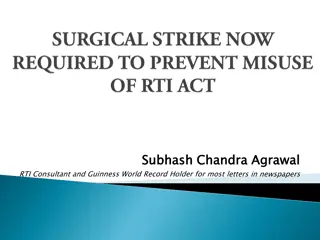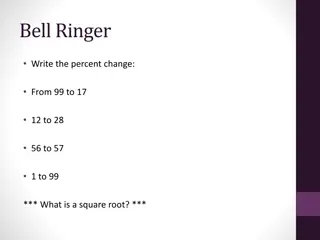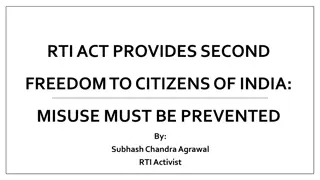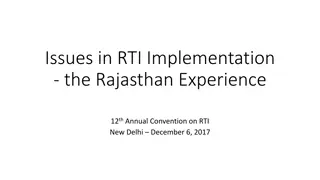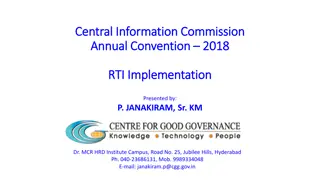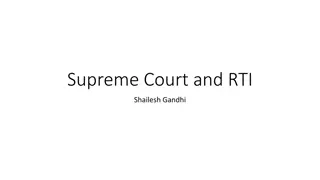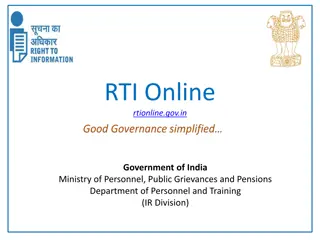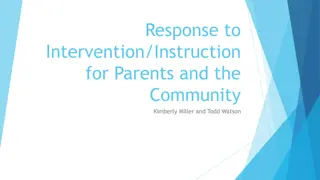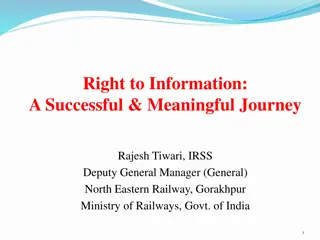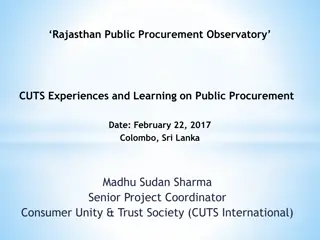Study on Transparency Law (RTI) at Grass-roots Level in Bihar and Rajasthan
This report delves into the role of Transparency Law (RTI) in enhancing democracy through public participation at the grassroots level in Bihar and Rajasthan, focusing on the comparative analysis of its implementation in villages and blocks. It aims to explore how RTI connects people to the government, particularly benefiting marginalized communities, and its impact on shifting towards participatory democracy. The study investigates the effectiveness of RTI in making local governance more transparent, accountable, and inclusive, with a focus on the socio-economic development of communities. Methodology involves consulting primary and secondary data sources, with primary data collected from selected districts' block and gram panchayat records.
Download Presentation

Please find below an Image/Link to download the presentation.
The content on the website is provided AS IS for your information and personal use only. It may not be sold, licensed, or shared on other websites without obtaining consent from the author.If you encounter any issues during the download, it is possible that the publisher has removed the file from their server.
You are allowed to download the files provided on this website for personal or commercial use, subject to the condition that they are used lawfully. All files are the property of their respective owners.
The content on the website is provided AS IS for your information and personal use only. It may not be sold, licensed, or shared on other websites without obtaining consent from the author.
E N D
Presentation Transcript
Transparency Law(RTI) at Grass-roots Level in Bihar and Rajasthan (India) Dr Susanta Kumar Mallick susantajnu@gmail.com Savitri Women s Collge,Bhanjanagar Odisha
Outline/Highlights of the Report Structure of the Report The Present Report is divided into five sections. The First section discussed about the Problems of the study, Scope and significance of the Study, Aims and Objectives of the Study, Research Methodology and Limitation of the Study. The Second section discussed the historical evolution of Transparency Law(RTI), Conceptual clarity of the law followed by review of the literatures on the subject. I will move on to discuss the relevance of RTI in third section. Then the researcher moves to discuss field experiences, observations and findings followed by a comparative study on the implementation of Transparency Law (RTI )between the two states (Bihar and Rajasthan) in the ground level (i.e.Block and G.P) level in Section Four. The last and final Section discussed the personal opinion, suggestions and recommendations for better implementation of RTI in local level to make RTI more success and fruitful.
Aims and Objectives To study and analyse the role of Transparency Law(RTI) as an instrument of strengthening democracy through public participation at grass roots level i.e block and village level. To do a comparative analysis of Transparency Law(RTI) status at local level (i.e. Village and Block) in two different states(Bihar and Rajasthan), how Transparency Law(RTI) has directly connected people with government to ventilate their grievances with the easiest way possible, especially for the poor and marginalized sections of society, to whom the benefits do not reach as easily. To study and analyse the role of Transparency Law (RTI) as a new right discourse in bringing shift from representative democracy to participatory democracy.
Contd. The focus was on the role of Transparency Law(RTI) at Local Level that is Block and Gram Panchayat Level and the people s participation in it towards the socio economic development taking a comparative study of two states -Bihar and Rajasthan. I was interested in exploring whether the right to information has made Blocks and Villages more transparent and accountable institutions at the grassroots level. The study also looks at how rights consciousness can play a role in making governance participatory. And, whether the Transparency Law(RTI) helps the poor and marginalized. The study will detailed how the new information regime was portrayed as providing every citizen of the state access to information under the control of public authorities consistent with public interest. The study also focused how the government is maintaining the main objective of Transparency Law(RTI) by providing information, whether it promote openness, transparency and accountability in administration, whether it ensure participation of people in all the matters related to Governance.
Methodology The primary and secondary sources of data was consulted . The primary data was collected by accessing the records of blocks and gram panchayats of the selected districts from the proposed field sites. Primary data also collected by doing sampling survey research of the gram panchayats coming under the blocks of Bihar and Rajasthan state. I have used research tools like open-ended, structured interviews with the villagers, RTI Applicants, public authorities, government officials, key informants, local politicians and political representatives. In order to collect data in the informal spheres in the gram panchayats I have conducted field survey in some panchayats randomly selected from the proposed study sites to collect first-hand data. The secondary source of data has involved consulting journals, government reports and documents. And finally, a comparative study has been made of data from the different gram panchayats of selected states and then findings have been analysed and presented.
Data Sample The researcher had visited a total of four districts of two states (see Table 1). The researcher had also visited and collected data from eight blocks and twenty six Gram Panchayats of these two states. A total of thirty five Public Information Officers (PIOs) are interacted during the field survey both at block and GP level. The researcher also interacted village level respondents to collect first hand information on the implementation of RTI at local level
Data Sample Name of the State No. of District & Block Visited No. of GPs Visited No. of PIOs Interacted No. of Villagers Interacted The researcher had visited a total of four districts of two states (see Table 1). The researcher had also visited and collected data from eight blocks and twenty six Gram Panchayats of states. A total of thirty five Public Information (PIOs) are interacted during the field survey both at block and GP level. The researcher also interacted village level respondents to collect first hand information implementation of RTI at local level Rajasthan Jaipur (Jhotwara & Sanganer) 15 19 105 these two Officers Nagaur (Mundwa & Nagaur) Bihar Patna(Sada r & Phulwari) 11 15 70 on the Bhagalpur( Naugachia & Rangara) 02 4 districts & 8 blocks 26 34 175
Limitations of the Study Four districts of two states were visited for data collection the researcher randomly selected eight blocks and twenty six Gram Panchayats of these two states. A total of thirty five Public Information Officers (PIOs) are interacted during the field survey both at block and GP level. The researcher also respondents to collect first hand information on the implementation of RTI at local level. interacted village level
Relevance of RTI It can change the secretive culture of government. RTI is a check on corrupt practices, it can unveil corruption. RTI can empower poor people. RTI can transform representative democracy into participatory democracy. It can further consolidate the trust between people and government.
RTI Awareness At Local Level
Field Observations and Major Findings RTI is being used as Hatiyar against corrupt practices & wrong activities. RTI were filed for the benefits of public interest. Majority of people said that they faced difficulties during filing the RTI. Women participation in RTI was very less. PIOs were not proper aware of RTI Act as well as powers and duties as PIOs. Due to lack of awareness on RTI people filed RTI with wrong public authority. Lack of proper arrangements of technology leads burden on officials
Contd. No proactive disclosure under 4 (1) (b) by the public authorities. Use of RTI is restricted to certain sections. There were no training, workshops and awareness programmes on Transparency Law(RTI) . Transparency Law(RTI) is being used for blackmailing & popularity by making it as news.
RTI in Bihar and Rajasthan: Comparative Perspective The people of Rajasthan were much more aware of RTI than the people of Bihar. Rajasthan PIOs had maintained RTI register but there was no RTI register in Bihar ( expect Naugachia and Rangra block). The PIOs of Bihar were trained by BIPRD whereas the PIOs of Rajasthan said that they had no training/workshops at all except the RTI booklets. The PIOs of Bihar and Rajasthan said that majority of RTI applications are filed for blackmailing purpose not for public interests and to harass the public officials.
Suggestions and Recommendations for better implementation of RTI RTI awareness programme such as RTI training and Workshops at both block and GP level is most needed to make RTI more effective at local level. Both state and Central government should take special attention to encourage the women by giving training and awareness on RTI to use RTI more to participation in the matter of governance and there should be more lady officers appointed as PIO to encourage the women. There should be a RTI help desk at every public authority . The government at local, state and central level should make sure that every public authority has the facility of computers, printers and photocopy machines which will be easy both for information provider and information seeker(to get information).
Contd. Government and Information Commissions should take immediate attention on the implementation of pro- disclosure matter under the RTI Act. Last but not least, to bring a positive feelings and encouragement among the PIOs for RTI there should be provisions for Rewards for PIOs who is delivering his duty properly and following the guidelines of RTI.


